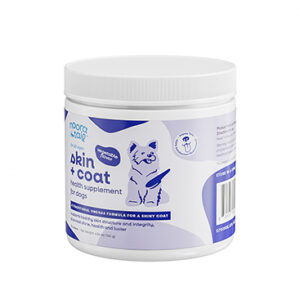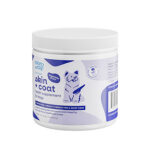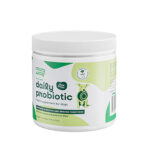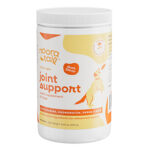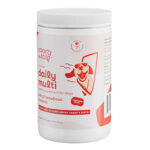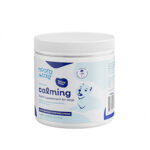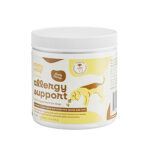Home Remedies for Dog Armpit Rash

Introduction
Armpit rashes in dogs can be a common and uncomfortable issue for our furry companions. These rashes can appear as red, inflamed, and itchy patches under the armpits and can cause significant discomfort. While seeking veterinary care is always recommended for persistent or severe rashes, there are several effective home remedies that can help alleviate symptoms and promote healing.
Causes of Dog Armpit Rash
- Bacterial or yeast infections: These infections can develop when moisture and bacteria or yeast accumulate in the armpits.
- Skin allergies: Food or environmental allergies can trigger inflammation and itching, leading to armpit rashes.
- Heat rash: When dogs become overheated, they can develop a heat rash.
- Contact dermatitis: Armpit rashes can result from contact with irritants, such as certain fabrics or chemicals.
- Friction: Rubbing or excessive licking can cause irritation and lead to armpit rashes.
Symptoms of Dog Armpit Rash
- Redness and inflammation under the armpits
- Itching and scratching
- Hair loss
- Discharge or crusting
- Unpleasant odor
Home Remedies for Dog Armpit Rash
1. Oatmeal Bath
Colloidal oatmeal has soothing and anti-inflammatory properties. To create an oatmeal bath, grind 1 cup of oatmeal into a fine powder. Add the powder to a lukewarm bath and let your dog soak for 10-15 minutes. Rinse thoroughly and pat dry.
2. Apple Cider Vinegar Rinse
Apple cider vinegar contains acetic acid, which has antibacterial and antifungal properties. Mix equal parts apple cider vinegar and water in a bottle. Apply the solution to the affected area with a cotton ball or gauze. Allow it to air dry.
3. Coconut Oil
Coconut oil has antimicrobial and anti-inflammatory properties. Apply a thin layer of unrefined coconut oil to the armpits several times a day.
4. Aloe Vera Gel
Aloe vera gel has soothing and cooling properties. Apply a small amount of pure aloe vera gel to the rash and let it air dry.
5. Witch Hazel
Witch hazel has astringent and antibacterial properties. Dilute witch hazel with water in a 1:1 ratio. Apply the solution to the rash with a cotton swab.
6. Baking Soda Paste
Baking soda can help neutralize odors and reduce inflammation. Mix 1 teaspoon of baking soda with 1 tablespoon of water to form a paste. Apply the paste to the armpits and let it dry for 10-15 minutes before rinsing.
7. Epsom Salt Soak
Epsom salt has antibacterial and anti-inflammatory properties. Dissolve 1/4 cup of Epsom salt in a warm bath and let your dog soak for 10-15 minutes. Rinse thoroughly and pat dry.
Prevention Tips
- Keep your dog’s armpits clean and dry.
- Trim excess hair around the armpits to reduce moisture buildup.
- Avoid overbathing your dog, as frequent bathing can strip natural oils from the skin.
- Use hypoallergenic shampoos and conditioners.
- Keep your dog cool and comfortable during warm weather.
- Address skin allergies promptly.
When to Seek Veterinary Care
While home remedies can provide relief, it is important to seek veterinary care if:
- The rash is severe or persists for more than a few days.
- The rash is accompanied by discharge or bleeding.
- Your dog is showing signs of pain or discomfort.
- You suspect an underlying medical condition.
A veterinarian can diagnose the underlying cause of the rash and recommend appropriate treatment.
Conclusion
Dog armpit rashes can be a common but treatable condition. By using effective home remedies and following prevention tips, you can help alleviate your dog’s discomfort and promote healthy skin. However, always consult with a veterinarian if the rash is severe or does not improve with home care.
Identify Underlying Cause:

A dog’s armpit, scientifically known as the axilla, can sometimes develop a rash, causing discomfort and irritation. It’s crucial to identify the underlying cause of the rash to determine the most effective treatment plan.
Causes of Dog Armpit Rashes
Armpit rashes in dogs can have various causes:
- Allergies: Environmental allergens such as pollen, dust mites, or food sensitivities can trigger an allergic reaction, leading to itching and rash.
- Bacterial Infection: Bacteria, such as Staphylococcus or Malassezia, can cause skin infections that manifest as a rash in the armpits.
- Irritants: Contact with harsh chemicals, soaps, or fabrics can irritate the delicate skin in the armpits.
- Heat and Moisture: Trapped heat and moisture in the armpit folds can create a breeding ground for bacteria and fungi, resulting in a rash.
- Underlying Medical Conditions: Certain underlying medical conditions, such as skin allergies, thyroid disorders, or hormonal imbalances, can contribute to skin rashes.
Identifying the Underlying Cause
To effectively treat a dog’s armpit rash, it’s essential to determine its underlying cause. Your veterinarian will gather information and perform a physical examination to assess the rash’s appearance, location, and severity.
- History: Detailed questions about your dog’s environment, diet, and any recent exposure to allergens or irritants can help narrow down the potential cause.
- Physical Examination: A thorough examination of the armpit rash, as well as the surrounding skin, will reveal its characteristics, such as redness, swelling, discharge, or hair loss.
- Diagnostic Tests: In some cases, additional diagnostic tests may be necessary, such as skin scrapings, cytology, or allergy tests, to pinpoint the specific cause.
Treatment Options
Once the underlying cause of the armpit rash is identified, your veterinarian will recommend an appropriate treatment plan tailored to your dog’s individual needs.
- Antihistamines: For allergic rashes, antihistamines can help reduce itching and inflammation.
- Antibiotics: Bacterial infections require antibiotic treatment to clear the infection and prevent further spread.
- Anti-Inflammatory Medications: Topical or oral medications can reduce inflammation and provide relief from discomfort.
- Shampoos and Conditioners: Medicated or hypoallergenic shampoos and conditioners can help soothe the skin, remove irritants, and prevent infection.
- Environmental Modifications: Identifying and eliminating environmental triggers, such as allergens or irritants, can help prevent future flare-ups.
- Underlying Medical Treatment: If the armpit rash is a symptom of an underlying medical condition, treating the primary issue will often resolve the skin problem.
Preventing Armpit Rashes
Implementing preventive measures can help reduce the risk of armpit rashes in dogs:
- Regular Grooming: Regular brushing and bathing help remove dead skin cells, allergens, and dirt that can contribute to irritation.
- Hypoallergenic Diet: If your dog has food allergies, switching to a hypoallergenic diet can eliminate potential triggers.
- Environmental Control: Keep your dog away from known allergens, such as pollen or dust mites, and regularly clean their bedding and surroundings.
- Avoid Harsh Chemicals: Use mild, hypoallergenic products when bathing or cleaning your dog’s environment.
- Trim Excess Hair: Long, thick hair in the armpits can trap heat and moisture, creating an environment conducive to bacteria and fungi.
When to Seek Veterinary Attention
If your dog develops an armpit rash that does not resolve with home care or if the rash is severe, it’s important to seek veterinary attention promptly. Persistent or worsening rashes can indicate an underlying medical condition or infection that requires proper diagnosis and treatment.
Warm Compress:

As a dog owner, it’s essential to be aware of the various health issues that can affect our furry companions. One common problem is armpit rashes, which can be uncomfortable and irritating for dogs. In this article, we will explore the causes, symptoms, and effective treatment options for dog armpit rashes.
Causes of Dog Armpit Rashes
The armpits, also known as axillae, are naturally moist and warm areas, which can make them prone to skin irritation. Various factors can contribute to the development of armpit rashes in dogs:
- Allergies: Environmental allergens such as pollen, dust, and mold can trigger allergic reactions in dogs, leading to itchy and inflamed skin in their armpits.
- Yeast Infections: Yeast, a type of fungus, can overgrow in the warm and moist environment of armpits, causing yeast infections.
- Bacterial Infections: Bacteria can enter the skin through breaks or cuts, resulting in bacterial infections that can manifest as armpit rashes.
- Skin Fold Dermatitis: Breeds with excessive skin folds, such as Bulldogs and Pugs, are more likely to develop skin fold dermatitis, which occurs when the skin becomes irritated and inflamed in the armpit folds.
- Poor Hygiene: Lack of proper grooming and bathing can allow dirt and debris to accumulate in the armpits, creating a breeding ground for bacteria and yeast.
Symptoms of Dog Armpit Rashes
Recognizing the symptoms of armpit rashes in dogs is crucial for prompt treatment:
- Itching and Licking: Dogs may experience intense itching and may be seen licking or chewing at their armpits excessively.
- Inflammation: The skin in the armpits may appear red, swollen, and irritated.
- Hair Loss: Inflammation and irritation can lead to hair loss in affected areas.
- Discharge: In some cases, armpit rashes may produce a discharge, which can be clear, yellow, or bloody.
- Open Sores: Chronic armpit rashes can develop into open sores or lesions.
Treatment Options for Dog Armpit Rashes
The treatment for dog armpit rashes depends on the underlying cause. Here are some common treatment options:
- Topical Medications: Anti-itch creams, anti-inflammatory ointments, and antifungal medications can be applied directly to the rash to reduce itching, inflammation, and infection.
- Antibiotics: In cases of bacterial infections, antibiotics may be prescribed to eliminate the bacteria responsible for the rash.
- Antifungals: Yeast infections require treatment with antifungal medications, which can be administered orally or topically.
- Antihistamines: If allergies are suspected to be the cause of the rash, antihistamines can help block the allergic reaction and reduce itching.
- Warm Compresses: Applying a warm compress to the rash can help soothe itching and inflammation.
- Grooming and Hygiene: Maintaining proper grooming and bathing routines is essential for preventing and treating armpit rashes. Regular brushing and bathing help remove dirt and debris, reducing the risk of skin irritation.
- Weight Management: Overweight or obese dogs are more prone to skin fold dermatitis. Maintaining a healthy weight can help prevent armpit rashes.
Prevention of Dog Armpit Rashes
While not all armpit rashes can be prevented, there are some steps you can take to minimize the risk:
- Regular Grooming: Brush your dog’s coat regularly to remove loose hair and dirt.
- Bathing: Bathe your dog as needed to keep their skin clean and free of allergens and bacteria.
- Avoid Allergens: As much as possible, keep your dog away from known allergens that may trigger a skin reaction.
- Manage Weight: Maintain a healthy weight for your dog to prevent skin fold dermatitis.
- Check for Skin Issues: Regularly check your dog’s armpits for any signs of redness, swelling, or irritation.
Conclusion
Dog armpit rashes can be a common problem, but understanding the causes and symptoms can help you identify and treat them effectively. By following the treatment options outlined above and implementing preventive measures, you can help keep your dog’s armpits healthy and comfortable. If you suspect your dog may have an armpit rash, consult with your veterinarian for a proper diagnosis and appropriate treatment.
Antiseptic Wipe:

Armpit rashes are common skin conditions in dogs, characterized by inflammation, redness, and discomfort. While they can be caused by various factors, including allergies, infections, and skin irritation, it’s crucial to address them promptly to prevent further complications. In this article, we’ll delve into the causes, symptoms, and effective treatment options for dog armpit rashes, including the use of antiseptic wipes.
Causes of Armpit Rashes in Dogs
- Allergies: Allergens such as pollen, dust mites, or certain foods can trigger allergic reactions, resulting in skin irritation and rashes in armpit areas.
- Bacterial or Fungal Infections: Bacteria or fungi can invade the skin, causing inflammation, redness, and pain. Common culprits include Staphylococcus and Malassezia yeasts.
- Skin Irritation: Friction from collars, harnesses, or other equipment can irritate delicate armpit skin, leading to rashes.
- Obesity: Overweight dogs have increased skin folds, which can trap moisture and create an ideal environment for bacteria and yeast to thrive, resulting in armpit rashes.
- Poor Hygiene: Lack of regular grooming can allow dirt and debris to accumulate in armpits, clogging hair follicles and causing irritation.
Symptoms of Armpit Rashes in Dogs
- Redness and Inflammation: Armpits appear pink or red, and the skin may be swollen or puffy.
- Itching and Discomfort: Dogs may scratch or lick their armpits excessively due to irritation.
- Lesions and Crusting: In severe cases, rashes can develop into open sores, scabs, or crusting.
- Odor: Bacterial or yeast infections can produce an unpleasant smell from armpits.
- Hair Loss: Rashes can cause hair to fall out or become matted in affected areas.
Treating Dog Armpit Rashes with Antiseptic Wipes
Antiseptic wipes are a convenient and effective way to clean and disinfect armpit rashes in dogs. They contain antiseptic agents that help to kill bacteria and prevent infection. Here’s how to use them:
- Clean the Area: Gently wipe the affected armpit with an antiseptic wipe to remove dirt, debris, and bacteria. Avoid using harsh chemicals or scrubbing the skin too vigorously.
- Remove Crusting: If there are crusts or scabs, dampen an antiseptic wipe and gently soak them for a few minutes before carefully removing them.
- Reduce Inflammation: Antiseptic wipes with anti-inflammatory properties can help to soothe irritated skin and reduce swelling.
- Apply Medicated Cream: After cleaning, apply a medicated cream or ointment prescribed by your veterinarian to treat the underlying cause of the rash (e.g., antibiotics for bacterial infections, antifungal cream for yeast infections).
Additional Treatment Options for Armpit Rashes
- Antihistamines: If allergies are the cause, your veterinarian may prescribe antihistamines to block the release of histamines, which trigger inflammation.
- Topical Antibiotics or Antifungals: For bacterial or fungal infections, topical antibiotics or antifungals can be directly applied to the affected area.
- Oral Medications: In severe cases, your veterinarian may prescribe oral antibiotics or antifungals to treat the infection systemically.
- Colloidal Oatmeal Baths: Oatmeal baths have soothing and anti-inflammatory properties that can help to reduce itching and irritation.
- Hypoallergenic Diet: If allergies are suspected, switching to a hypoallergenic diet can help to eliminate potential allergens.
Preventing Armpit Rashes in Dogs
- Regular Grooming: Brush your dog’s coat regularly to remove loose hair and debris that can accumulate in armpits.
- Appropriate Collars and Harnesses: Use well-fitting collars and harnesses that don’t chafe or irritate armpit skin.
- Weight Management: Maintain a healthy weight for your dog to reduce skin folds and prevent moisture buildup.
- Hygienic Environment: Keep your dog’s living area clean and free from potential allergens.
- Regular Veterinary Checkups: Schedule regular veterinary checkups to detect and address skin conditions early on.
When to Seek Veterinary Attention
If your dog’s armpit rash persists, worsens, or shows signs of infection (e.g., drainage, swelling, heat), it’s crucial to seek veterinary attention promptly. Your veterinarian can determine the underlying cause of the rash and provide appropriate treatment.
Oatmeal Bath:

Dog armpit rashes, also known as intertrigo, are common skin irritations that affect the sensitive skin in the folds of the dog’s armpits. These rashes can be caused by a variety of factors, including allergies, bacterial or fungal infections, poor hygiene, and excessive moisture.
Symptoms of Dog Armpit Rashes
Armpit rashes in dogs can manifest in several ways:
- Redness and inflammation: The skin in the armpits becomes red, swollen, and irritated.
- Itching: The dog may scratch or lick the affected area excessively, leading to further irritation.
- Oozing or crusting: The rash may produce a clear or yellowish fluid that can crust or dry out.
- Odor: A foul odor may emanate from the armpits due to bacterial or fungal infection.
- Hair loss: In severe cases, the rash can cause hair loss in the armpit area.
Causes of Dog Armpit Rashes
- Allergies: Dogs who are allergic to certain substances, such as grasses, pollen, or food, may develop armpit rashes as a reaction.
- Bacterial or fungal infections: Bacteria or fungi can become trapped in the moist folds of the armpits and cause an infection.
- Poor hygiene: Infrequent bathing or grooming can lead to an accumulation of dirt and bacteria, contributing to rashes.
- Excessive moisture: Dogs who spend extended periods in damp or humid environments may develop armpit rashes due to moisture retention.
- Obesity: Overweight and obese dogs are more prone to armpit rashes due to the increased friction and moisture in the armpit folds.
- Skin folds: Dogs with excessive skin folds, such as Bulldogs and Shar-Peis, are more susceptible to armpit rashes.
Treatment for Dog Armpit Rashes
The treatment for dog armpit rashes depends on the underlying cause.
- Oatmeal Bath: Bathe the dog with an oatmeal-based shampoo to relieve inflammation and itching. Oatmeal has soothing and anti-inflammatory properties.
- Antibacterial or antifungal medication: If the rash is caused by a bacterial or fungal infection, the veterinarian may prescribe topical or oral medications to treat the infection.
- Antihistamines: For rashes caused by allergies, antihistamines can be given to reduce itching and inflammation.
- Dietary changes: If allergies are suspected, the veterinarian may recommend a hypoallergenic diet to eliminate potential allergens.
- Weight management: For obese dogs, weight loss can help reduce friction and moisture in the armpit folds.
- Keeping the area dry: Regularly clean and dry the armpit area to prevent moisture accumulation. Use a soft, damp cloth or antibacterial wipes to gently wipe away any discharge or crust.
- Gentle grooming: Groom the dog regularly to remove loose hair and keep the area free of debris. Avoid over-grooming, as this can irritate the skin.
- Protective barriers: In severe cases, the veterinarian may recommend using a protective barrier, such as a diaper or gauze, to cover the affected area.
Prevention of Dog Armpit Rashes
- Maintain good hygiene: Bathe the dog regularly and groom them to remove loose hair and debris.
- Keep the environment dry: Avoid exposing the dog to damp or humid conditions for extended periods.
- Manage allergies: Identify and avoid allergens that trigger the dog’s allergies.
- Control weight: Maintain a healthy weight for the dog to reduce friction and moisture in the armpit folds.
- Trim excessive skin folds: For dogs with excessive skin folds, trim the folds regularly to prevent moisture accumulation.
- Use a skin cleanser: Regularly use a gentle skin cleanser to remove dirt and bacteria from the armpit area.
Conclusion
Dog armpit rashes are common skin irritations that can be caused by a variety of factors. By understanding the symptoms, causes, and treatment options, pet owners can effectively manage and prevent armpit rashes in their dogs. Maintaining good hygiene, addressing underlying allergies or infections, and taking preventive measures can help keep the dog’s armpits healthy and comfortable.
Hydrocortisone Cream:
Dog armpit rashes, also known as intertrigo, are common skin conditions that can cause discomfort and inconvenience for your furry friend. Understanding the causes and symptoms of dog armpit rashes is crucial for effective treatment and prevention.
Causes of Dog Armpit Rashes
- Skin Fold Dermatitis: Excess skin folds in armpits create warm, moist environments that are ideal for bacteria and yeast to thrive, leading to inflammation and infection. This condition is more prevalent in certain breeds, such as Bulldogs, Shar-Peis, and Pugs.
- Allergies and Irritants: Allergies to food, environmental triggers, or contact with irritants can cause rashes and inflammation in dog armpits. Allergens include pollen, dust mites, flea bites, and some fabrics.
- Bacterial and Fungal Infections: Staph and yeast infections can infect the skin in dog armpits, leading to redness, itching, and discomfort. These infections can be caused by poor hygiene, excessive moisture, or underlying skin conditions.
- Poor Hygiene: Insufficient grooming and bathing can allow dirt and bacteria to accumulate in armpits, contributing to skin irritation and rashes.
- Wet or Damp Conditions: Constant exposure to moisture, such as from excessive licking or rain, can soften the skin and make it more susceptible to infection and inflammation.
Symptoms of Dog Armpit Rashes
- Redness and Inflammation: Armpits become red, irritated, and warm to the touch.
- Itching and Discomfort: Dogs may excessively lick or scratch their armpits to relieve itching.
- Moist or Weepy Discharge: Bacterial or fungal infections may cause armpits to become moist or release a weepy discharge.
- Odor: Armpit rashes can emit an unpleasant odor due to bacteria or yeast overgrowth.
- Scabs or Crusting: In severe cases, armpit rashes may develop scabs or crusting as the skin tries to heal.
Treatment Options
Treating dog armpit rashes typically involves addressing the underlying cause and providing symptomatic relief. Here are some common treatment options:
- Topical Hydrocortisone Cream: Apply a small amount of a topical hydrocortisone cream to reduce itching and swelling. Only use as directed by your veterinarian, as overuse can thin the skin.
- Antibacterial or Antifungal Medications: If an infection is present, your veterinarian may prescribe oral antibiotics or antifungal medications to clear the infection.
- Medicated Shampoos and Wipes: Antibacterial and antifungal shampoos and wipes can help cleanse and disinfect the affected area, reducing inflammation and preventing further infections.
- Regular Grooming: Thoroughly groom your dog to remove excess hair and debris that can contribute to rash development.
- Keep Armpits Dry: Protect your dog’s armpits from constant moisture by using a waterproof barrier, such as a diaper or towel, during wet conditions.
- Manage Allergies: If allergies are suspected, identify and eliminate the offending allergens to prevent further flare-ups.
- Weight Loss: For obese or overweight dogs, losing weight can reduce skin fold dermatitis and improve armpit health.
Prevention of Dog Armpit Rashes
- Regular Bathing and Grooming: Keep your dog’s armpits clean by bathing them regularly and trimming excess hair around the area.
- Moisture Control: Avoid exposing your dog to excessive moisture or wet conditions for extended periods. Use waterproof barriers if necessary.
- Hygienic Environment: Ensure your dog’s bedding and surroundings are clean and free from dirt and debris.
- Dietary Management: Feed your dog a balanced and nutritious diet to support their immune system and reduce allergies.
- Parasite Control: Regularly treat your dog for fleas and other parasites to prevent skin irritation and infections.
- Regular Veterinary Exams: Take your dog for regular veterinary check-ups to monitor their skin health and address any potential issues early on.
By understanding the causes, symptoms, and treatment options for dog armpit rashes, you can effectively care for your furry friend and ensure their comfort. Remember to consult with your veterinarian for proper diagnosis and personalized treatment advice based on your dog’s specific condition.
Antibiotic Ointment:
Armpit rashes in dogs are a common skin condition that can cause discomfort and irritation. While there are several potential causes, most cases are the result of bacterial or fungal infections, allergies, or parasites. In this article, we will explore the various causes of armpit rashes in dogs and provide comprehensive treatment options to help alleviate your furry friend’s discomfort.
Causes of Armpit Rashes in Dogs
1. Bacterial Infection: Bacteria, such as Staphylococcus and Streptococcus, can cause skin infections that lead to armpit rashes. These infections can occur due to open wounds, cuts, or bites that allow bacteria to penetrate the skin.
2. Fungal Infection: Fungi, like Malassezia, can thrive in warm, moist areas like the armpits, causing skin irritation and rash. These infections are often associated with underlying allergies or immune system imbalances.
3. Allergies: Allergies to food, environmental triggers (e.g., pollen, dust), or contact irritants (e.g., grooming products) can cause armpit rashes as a result of excessive scratching and licking.
4. Parasites: Parasites such as mites or scabies can burrow into the skin, causing intense itching and rash. These parasites often invade areas with thin skin, making the armpits a common target.
Symptoms of Armpit Rashes
Armpit rashes in dogs can manifest in various symptoms, including:
- Redness and inflammation
- Hair loss in the affected area
- Excessive scratching and licking
- Crusty or scaly skin
- Sores or ulcers
- Foul odor
Treatment Options
The treatment approach for armpit rashes in dogs depends on the underlying cause. Here are some common treatments:
1. Antibiotic Ointment: If bacterial infection is suspected, your veterinarian may prescribe an antibiotic ointment to kill the bacteria and prevent further infection.
2. Antifungal Cream: For fungal infections, topical antifungal creams or oral antifungal medication may be prescribed to reduce the fungal population and relieve inflammation.
3. Allergen Avoidance: If allergies are the underlying cause, identifying and avoiding the allergen is crucial. This may involve dietary changes, environmental modifications, or allergy testing.
4. Anti-Itch Medication: Antihistamines or corticosteroids can help reduce itching and inflammation, providing temporary relief to dogs while the underlying cause is being addressed.
5. Parasite Treatment: In cases of parasitic infections, topical or oral medications may be prescribed to eliminate the parasites and prevent further infestation.
6. Oatmeal Baths: Oatmeal has soothing and anti-inflammatory properties that can help relieve the discomfort of armpit rashes. Oatmeal baths or oatmeal-based shampoos can be used to cleanse the affected area and reduce irritation.
7. Elizabethan Collar: Additionally, an Elizabethan collar may be recommended to prevent the dog from scratching or licking the affected area, allowing the skin to heal undisturbed.
Prevention
Preventing armpit rashes in dogs involves addressing potential causes, such as:
- Keeping your dog’s coat clean and well-groomed
- Avoiding harsh grooming products or detergents
- Managing allergies through dietary changes or environmental modifications
- Regularly checking your dog for parasites and treating any infections promptly
- Maintaining a healthy immune system through proper nutrition and exercise
When to See a Veterinarian
If your dog develops an armpit rash, it is important to consult with your veterinarian. This will ensure an accurate diagnosis and appropriate treatment plan. Veterinary care is particularly crucial if the rash is severe, does not respond to home treatments, or is accompanied by other symptoms such as fever, lethargy, or discharge.
Conclusion
Armpit rashes in dogs can be a source of discomfort and frustration. Understanding the underlying causes and implementing effective treatments is crucial for alleviating your dog’s symptoms and preventing future occurrences. By following the guidelines provided in this article and consulting with your veterinarian, you can help your furry friend get back to a healthy and comfortable life.
Tea Tree Oil:
Armpit rash in dogs is a common skin condition that can cause discomfort and irritation. While there are various causes of armpit rash, some of the most common ones include skin allergies, yeast infections, and bacterial infections. In this article, we will delve into the different treatment options available for dog armpit rash, including natural remedies and over-the-counter medications.
Causes of Dog Armpit Rash
Before diving into the treatment options, it is essential to understand the potential causes of armpit rash in dogs. Here are some of the most common ones:
-
Skin Allergies: Dogs can develop allergies to various substances, including food ingredients, environmental allergens, and contact allergens. When exposed to an allergen, the immune system overreacts, leading to inflammation and itching of the skin.
-
Yeast Infections: Yeast overgrowth can also cause armpit rash in dogs. Yeast, a type of fungus, can thrive in warm, moist environments and cause irritation and itching.
-
Bacterial Infections: Bacteria can also enter the skin through cuts or abrasions, leading to an infection and armpit rash.
Symptoms of Dog Armpit Rash
Recognizing the symptoms of armpit rash in dogs is essential for timely treatment. Here are some common signs to watch out for:
-
Redness and Inflammation: The skin around the armpits appears red and inflamed.
-
Itching and Discomfort: Dogs may scratch or lick excessively at the rash area due to discomfort.
-
Discharge: In some cases, the rash may produce a discharge that can be clear, yellow, or green in color.
-
Bald Spots: Chronic armpit rash can lead to hair loss and bald spots.
-
Pain and Sensitivity: Some dogs may experience pain or sensitivity when the affected area is touched.
Treatment Options for Dog Armpit Rash
The treatment for dog armpit rash depends on the underlying cause. Here are some common treatment options:
-
Home Remedies: For mild rashes that are not caused by an infection, some home remedies may provide relief. These include:
-
Oatmeal baths: Oatmeal has soothing and anti-inflammatory properties that can help reduce itching and inflammation.
-
Aloe vera: Aloe vera gel can also be applied topically to soothe and cool the rash.
-
Coconut oil: Coconut oil has antimicrobial and antifungal properties that can help treat yeast infections and bacterial infections.
-
Over-the-Counter Medications: If home remedies do not provide sufficient relief, over-the-counter medications may be necessary. These include:
-
Antihistamines: Antihistamines can help reduce itching and inflammation caused by allergies.
-
Antifungal creams: Antifungal creams are used to treat yeast infections.
-
Antibacterial ointments: Antibacterial ointments can help treat bacterial infections.
-
Prescription Medications: In severe cases of armpit rash, prescription medications may be necessary. These may include:
Prevention of Dog Armpit Rash
Preventing armpit rash in dogs is always better than treating it. Here are some tips:
-
Keep your dog clean and dry: Regularly bathe your dog to remove dirt and allergens. Make sure to dry them thoroughly, especially in the armpit area.
-
Control allergies: If your dog has allergies, identify and avoid the allergens. You may need to consult with a veterinarian for allergy testing.
-
Avoid excessive grooming: Excessive grooming can irritate the skin and increase the risk of infection.
-
Trim your dog’s hair: Dogs with long hair may be more prone to armpit rash. Trim their hair short to keep the area clean and dry.
Conclusion
Dog armpit rash is a common condition that can cause discomfort and irritation. By understanding the potential causes and symptoms, you can effectively treat the rash and prevent it from recurring. If home remedies are not sufficient, consult your veterinarian for proper diagnosis and treatment. With proper care, your dog can find relief from armpit rash and enjoy a comfortable and healthy life.
Aloe Vera Gel:
As a dog owner, it’s essential to be aware of the various skin ailments that can affect your beloved furry friend. One common skin condition in dogs is armpit rash. This article will provide comprehensive information on the causes, symptoms, and effective home remedies for dog armpit rashes.
Causes of Dog Armpit Rashes
Armpit rashes in dogs can stem from a variety of factors, including:
- Allergies: Environmental allergens such as pollen, dust, or certain foods can trigger allergic reactions that manifest as rashes.
- Skin Irritants: Contact with harsh chemicals, soaps, detergents, or grooming products can irritate the delicate skin of a dog’s armpits.
- Fungal Infections: Warm, moist environments provide an ideal breeding ground for fungi, which can cause yeast infections and ringworm in dogs.
- Bacterial Infections: A puncture wound or cut in the armpit can allow bacteria to enter the skin and lead to an infection.
- Parasites: Mites or fleas can burrow into the skin, causing irritation and rashes.
- Skin Folds: Dogs with excessive skin folds in their armpits may experience chafing and irritation.
- Autoimmune Disorders: Certain autoimmune disorders can affect the skin and cause rashes in dogs.
Symptoms of Dog Armpit Rashes
Dogs with armpit rashes may exhibit the following symptoms:
- Redness, swelling, or inflammation
- Itching or scratching
- Hair loss in the affected area
- Crusty or scaly patches
- Foul odor
- Discharge (in the case of infections)
Home Remedies for Dog Armpit Rashes
While it’s important to consult a veterinarian if your dog develops an armpit rash, there are several home remedies that can provide relief:
- Aloe Vera Gel: Extract the gel from an aloe vera leaf and apply it to the rash to soothe and heal.
- Baking Soda Paste: Create a paste with baking soda and water and apply it to the rash to neutralize acids and reduce inflammation.
- Colloidal Oatmeal Baths: Oatmeal baths can help soothe irritated skin and reduce itching.
- Apple Cider Vinegar: Dilute apple cider vinegar in water and apply it to the rash using a cotton ball. Its antibacterial and antifungal properties can help combat infections.
- Tea Tree Oil: Dilute tea tree oil in a carrier oil (such as coconut oil) and apply it sparingly to the rash. It has antibacterial and antifungal properties.
- Benadryl: If allergies are suspected, administering Benadryl (diphenhydramine) can help reduce itching and inflammation. Consult a veterinarian for the appropriate dosage.
Prevention and Management
To prevent and manage armpit rashes in dogs, consider the following tips:
- Keep your dog’s skin clean and dry.
- Avoid using harsh chemicals or detergents on your dog’s skin.
- Manage allergies by identifying and avoiding triggers.
- Treat skin infections promptly to prevent further irritation.
- Trim excessive hair in the armpits to reduce moisture and chafing.
- Use hypoallergenic grooming products to minimize skin irritation.
Conclusion
Armpit rashes in dogs can be a common skin condition, but with proper care and treatment, they can be effectively managed. By understanding the causes, symptoms, and home remedies discussed in this article, you can provide your furry companion with much-needed relief and prevent future occurrences of armpit rashes. Remember, if the rash persists or worsens, it’s crucial to seek professional veterinary help to rule out underlying medical conditions and ensure the best possible outcome for your dog’s health.









